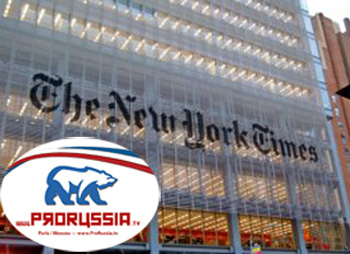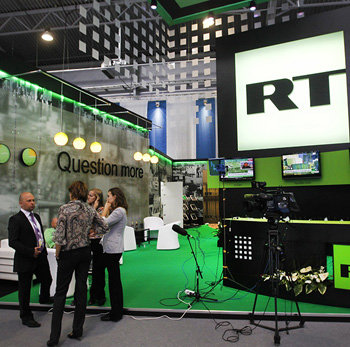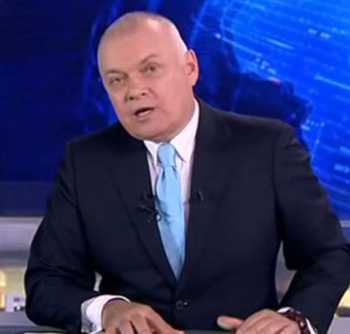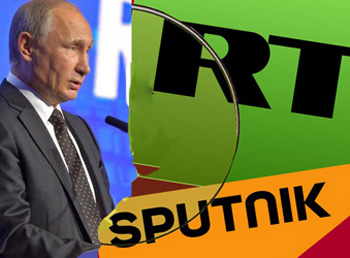International Affairs
 |
 |
 |
 |
 |
 |
 |
New York Times Strikes Again - Says Russian Propaganda War ‘May Be Impossible To Stop’
The New York Times is nothing if not consistent. The so-called "newspaper of record" has spent decades giving support to the propaganda efforts of Moscow and its allies since the advent of the Soviet Union.
 In the 1920s and early 1930s, New York Times Moscow correspondent Walter Duranty promoted pro-Soviet propaganda although he knew the Communist Party line was false. Closer to home, in the late 1950s and early 1960s, The New York Times provided a platform for Herbert Matthews' pro-Castro lies. The New York Times support of the Party line continued throughout the Cold War.
In the 1920s and early 1930s, New York Times Moscow correspondent Walter Duranty promoted pro-Soviet propaganda although he knew the Communist Party line was false. Closer to home, in the late 1950s and early 1960s, The New York Times provided a platform for Herbert Matthews' pro-Castro lies. The New York Times support of the Party line continued throughout the Cold War.
With the rise of Putin's neo-Soviet Russia, The New York Times again follows the Moscow line, and in a recent article declares any struggle against Moscow's latest propaganda offensive to be an all but lost cause.
For Moscow's part, the stated purpose of its latest and glitzy manipulation of broadcast media and use of social media is to break "the Anglo-Saxon global information streams."
The article refers to an "intelligence assessment" examining Russia's propaganda machine, primarily the television channels Sputnik and RT (formerly known as Russia Today), and describes these international broadcasters as working with Moscow's intelligence services to subvert Western democracies. Moscow's combination of broadcasting and social media is described in the title of the article as "one of the most powerful information weapons of the 21st century," with the included speculation that it "may be impossible to stop."
'Assessment' gives Russia 'high marks' on propaganda
The declassified "intelligence assessment," entitled “Assessing Russian Activities and Intentions in Recent U.S. Elections,” is derived from a classified report. The "intelligence assessment" contains various unsubstantiated speculations against the winner of the 2016 presidential race, Donald J. Trump.
 The greater part of the assessment, however, concerns the coordinated activities of the RT and Sputnik television broadcasters and Moscow-inspired social-media, which is defined as “Russia’s state-run propaganda machine.” Russia's sophisticated use of propaganda is also an important tool in what is sometimes called "hybrid warfare," the combined use of military assets with various Internet/social media resources.
The greater part of the assessment, however, concerns the coordinated activities of the RT and Sputnik television broadcasters and Moscow-inspired social-media, which is defined as “Russia’s state-run propaganda machine.” Russia's sophisticated use of propaganda is also an important tool in what is sometimes called "hybrid warfare," the combined use of military assets with various Internet/social media resources.
America's ability to counter such propaganda, according to the New York Times," is questionable, and has always been so. The reality that more Soviet citizens listened, often at great risk, to U.S. broadcasts than did U.S. citizens freely tune into Radio Moscow "was not entirely a matter of America's having a better story to tell." For the NYT author, a deciding factor was the inability to access Radio Moscow on anything but short-wave radio.
The NYT author ignores the political circumstance that few Americans were interested in spending a modest amount to purchase a specialized but readily available radio to listen to Radio Moscow. (By the 1960s, Americans had the opportunity to buy a portable short-wave radio at very low cost, which easily brought in Radio Moscow's very strong and clear signal).
American apathy toward obtaining the Soviet view of things does not deter the New York Times assessment of the effectiveness of Cold War Soviet propaganda. The NYT article cited the results of an unnamed professor at Florida State University indicating "Americans who listened to Radio Moscow broadcasts developed more open attitudes toward the USSR than those of average Americans."
That few Americans had any interest in Radio Moscow as opposed to Soviet citizens who were willing to go to prison, lose employment or end up in a Soviet psychiatric ward just for the opportunity to secretly listen to American broadcasts eludes the article's author – and probably the entire staff of the New York Times.
'Objectivity is a myth'
Today, Moscow's propaganda comes in a more glitzy, trendy package, but with the same basic anti-West, anti-U.S. message. In style, RT and Sputnik are patterned after major news outlets such as the BBC and CNN. In 2008 RT obtained the services of the New York-based McCann advertising agency (Coca-Cola's "It's the real thing" and other well-known ads). McCann developed the slogan/ad campaign "Question More" for RT which now positions itself as the outsider challenging the establishment.
The content of RT and Sputnik, however, has a distinct purpose. While RT director general Alexey Nikolov recently declared in a speech, quoted in the NYT article, that all "must have the right to know different news, coming from different sources, and then make their own judgment," this "right" does not extend to those living in Russia – where criticism of the government can be fatal.
 Dmitry Kiselyov who is described in the NYT article as "manager" of Rossiay Segodnya, the parent of RT and Sputnik, declared in the article that "Journalism … is an instrument of the country" and that "objectivity is a myth." Kiselyov affirmed that the editorial policy of Rossiay Segodnya was "associated with love for Russia."
Dmitry Kiselyov who is described in the NYT article as "manager" of Rossiay Segodnya, the parent of RT and Sputnik, declared in the article that "Journalism … is an instrument of the country" and that "objectivity is a myth." Kiselyov affirmed that the editorial policy of Rossiay Segodnya was "associated with love for Russia."
"Love for Russia" also means taking part in the "hybrid war" strategy developed by Russian General Valery Gerasimov. As the New York Times article acknowledges, Russia's new military doctrine envisions "a complex use of military force, political, economic, informational and other means of non-military character, applied with a large use of the populations protest potential." Dmitri Peskov is quoted in the NYT article as telling America that RT and Sputnik will "tell you about yourself."
Kiselyov described Sputnik as directed toward those who are "tired of aggressive propaganda of a unipolar world." A "unipolar world" is the term used to describe American leadership as opposed to direction from Moscow and Beijing.
The New York Times article acknowleges that RT and Sputnik are the "nucleus of an assertively pro-Russian, frequently anti-West information network..." With objectivity as a "myth" and "love for Russia" as paramount, it takes little imagination to link RT, Sputnik, and various social media trolls with "hybrid war" being waged inside the United States.
The Russian government, as one would expect, sees it differently. The New York Times article quotes Margarita Simonyan, editor in chief for Rossiya Segodnya, as describing U.S. intelligence concerns as only intended to "blacklist all reporting, including by American media, as some pro-Russia campaign if any facts or views in them don't support the right kind of narrative... It is the sad history of McCarthyism repeating itself ..."
 The New York Times enters the fray by portraying RT and Sputnik as, in fact, like any other news media. The article asks "How exactly do you draw a line between RT and Sputnik and, say, Sean Hannity" of Fox News? The same paragragh mentions Alex Jones's Infowars. Because of this supposed difficulty of separating accuracy from opinion, we are to believe it is impossible to counter RT/Sputnik or Moscow's propaganda machine in general.
The New York Times enters the fray by portraying RT and Sputnik as, in fact, like any other news media. The article asks "How exactly do you draw a line between RT and Sputnik and, say, Sean Hannity" of Fox News? The same paragragh mentions Alex Jones's Infowars. Because of this supposed difficulty of separating accuracy from opinion, we are to believe it is impossible to counter RT/Sputnik or Moscow's propaganda machine in general.
One may begin with RT's slogan "Question More." Where can one really employ this slogan – in the U.S. or Putin's Russia? The blood-stained streets and apartment hallways of Moscow and other Russian cities should answer that. While Russia's news is controlled, the U.S. tolerates various opinions, including the very bizarre. It may also be said that Hannity acknowledges his ties with President Trump and does seek to draw distinctions between fact and his own beliefs.
The simple truth is that Russia's "news" outlets exist to promote Moscow's international strategy, which, considering the Moscow elite's affection for all things Soviet, is nothing more than a modestly updated form of the Russian Communist plan for global domination.
The New York Times had no problem with Moscow's strategy in the 1920s, and it sees no problem with surrendering to the modernized version today. Ah! Consistency.

Toby Westerman publishes
International News Analysis - Today
An uncompromising weekly analysis of the world situation
Contact T. Westerman at
www.inatoday.com
or P.O. BOX 5182, Rockford, ILL, 61125-0182

The NYT - consistently pro-Russia
With the rise of Putin's neo-Soviet Russia, The New York Times again follows the Moscow line, and in a recent article declares any struggle against Moscow's latest propaganda offensive to be an all but lost cause.
For Moscow's part, the stated purpose of its latest and glitzy manipulation of broadcast media and use of social media is to break "the Anglo-Saxon global information streams."
The article refers to an "intelligence assessment" examining Russia's propaganda machine, primarily the television channels Sputnik and RT (formerly known as Russia Today), and describes these international broadcasters as working with Moscow's intelligence services to subvert Western democracies. Moscow's combination of broadcasting and social media is described in the title of the article as "one of the most powerful information weapons of the 21st century," with the included speculation that it "may be impossible to stop."
'Assessment' gives Russia 'high marks' on propaganda
The declassified "intelligence assessment," entitled “Assessing Russian Activities and Intentions in Recent U.S. Elections,” is derived from a classified report. The "intelligence assessment" contains various unsubstantiated speculations against the winner of the 2016 presidential race, Donald J. Trump.

RT and Sputnik, State-controlled organs that can only ask the 'right' questions
America's ability to counter such propaganda, according to the New York Times," is questionable, and has always been so. The reality that more Soviet citizens listened, often at great risk, to U.S. broadcasts than did U.S. citizens freely tune into Radio Moscow "was not entirely a matter of America's having a better story to tell." For the NYT author, a deciding factor was the inability to access Radio Moscow on anything but short-wave radio.
The NYT author ignores the political circumstance that few Americans were interested in spending a modest amount to purchase a specialized but readily available radio to listen to Radio Moscow. (By the 1960s, Americans had the opportunity to buy a portable short-wave radio at very low cost, which easily brought in Radio Moscow's very strong and clear signal).
American apathy toward obtaining the Soviet view of things does not deter the New York Times assessment of the effectiveness of Cold War Soviet propaganda. The NYT article cited the results of an unnamed professor at Florida State University indicating "Americans who listened to Radio Moscow broadcasts developed more open attitudes toward the USSR than those of average Americans."
That few Americans had any interest in Radio Moscow as opposed to Soviet citizens who were willing to go to prison, lose employment or end up in a Soviet psychiatric ward just for the opportunity to secretly listen to American broadcasts eludes the article's author – and probably the entire staff of the New York Times.
'Objectivity is a myth'
Today, Moscow's propaganda comes in a more glitzy, trendy package, but with the same basic anti-West, anti-U.S. message. In style, RT and Sputnik are patterned after major news outlets such as the BBC and CNN. In 2008 RT obtained the services of the New York-based McCann advertising agency (Coca-Cola's "It's the real thing" and other well-known ads). McCann developed the slogan/ad campaign "Question More" for RT which now positions itself as the outsider challenging the establishment.
The content of RT and Sputnik, however, has a distinct purpose. While RT director general Alexey Nikolov recently declared in a speech, quoted in the NYT article, that all "must have the right to know different news, coming from different sources, and then make their own judgment," this "right" does not extend to those living in Russia – where criticism of the government can be fatal.

Media Director Kiselyov is clear:
'Objectivity is a myth'
"Love for Russia" also means taking part in the "hybrid war" strategy developed by Russian General Valery Gerasimov. As the New York Times article acknowledges, Russia's new military doctrine envisions "a complex use of military force, political, economic, informational and other means of non-military character, applied with a large use of the populations protest potential." Dmitri Peskov is quoted in the NYT article as telling America that RT and Sputnik will "tell you about yourself."
Kiselyov described Sputnik as directed toward those who are "tired of aggressive propaganda of a unipolar world." A "unipolar world" is the term used to describe American leadership as opposed to direction from Moscow and Beijing.
The New York Times article acknowleges that RT and Sputnik are the "nucleus of an assertively pro-Russian, frequently anti-West information network..." With objectivity as a "myth" and "love for Russia" as paramount, it takes little imagination to link RT, Sputnik, and various social media trolls with "hybrid war" being waged inside the United States.
The Russian government, as one would expect, sees it differently. The New York Times article quotes Margarita Simonyan, editor in chief for Rossiya Segodnya, as describing U.S. intelligence concerns as only intended to "blacklist all reporting, including by American media, as some pro-Russia campaign if any facts or views in them don't support the right kind of narrative... It is the sad history of McCarthyism repeating itself ..."

Content controlled by the government
One may begin with RT's slogan "Question More." Where can one really employ this slogan – in the U.S. or Putin's Russia? The blood-stained streets and apartment hallways of Moscow and other Russian cities should answer that. While Russia's news is controlled, the U.S. tolerates various opinions, including the very bizarre. It may also be said that Hannity acknowledges his ties with President Trump and does seek to draw distinctions between fact and his own beliefs.
The simple truth is that Russia's "news" outlets exist to promote Moscow's international strategy, which, considering the Moscow elite's affection for all things Soviet, is nothing more than a modestly updated form of the Russian Communist plan for global domination.
The New York Times had no problem with Moscow's strategy in the 1920s, and it sees no problem with surrendering to the modernized version today. Ah! Consistency.

Posted November 8, 2017
International News Analysis - Today
An uncompromising weekly analysis of the world situation
Contact T. Westerman at
www.inatoday.com
or P.O. BOX 5182, Rockford, ILL, 61125-0182
______________________
______________________
 Volume I |
 Volume II |
 Volume III |
 Volume IV |
 Volume V |
 Volume VI |
 Volume VII |
 Volume VIII |
 Volume IX |
 Volume X |
 Volume XI |
 Special Edition |


